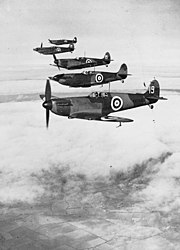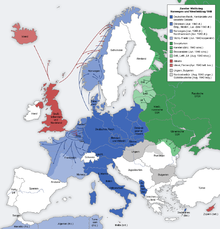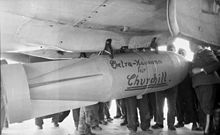Battle of Britain
![]()
The title of this article is ambiguous. For a description of the 1969 film, see Battle of Britain (film).
The Battle of Britain
Part of: World War II

Spitfires of the squadron 19, RAF
The Battle of Britain was the German Luftwaffe's attempt to force Britain's surrender or prepare for the planned invasion of the island by launching air attacks against British forces and British cities between the summer of 1940 and early 1941, following its victory over France in World War II. Known internationally as the Battle of Britain, the Battle of the Air was a series of engagements in British airspace fought by the German Luftwaffe against the Royal Air Force (RAF). British historians place the period of the battle from 10 July to 31 October 1940, as from that date daylight raids ceased on a larger scale. Some sources and statistics refer to a period up to May 1941, when the Luftwaffe fighter squadrons were withdrawn for Unternehmen Barbarossa.
The aim of the High Command of the Wehrmacht in the Battle of Britain was to achieve air supremacy over British airspace by destroying the Royal Air Force (RAF). This was considered a basic requirement for a successful invasion, the planning for which had been discussed between Hitler and Grand Admiral Raeder as early as December 1939 (Unternehmen Seelöwe). However, Hitler later hoped to be able to force Great Britain into peace negotiations by intensifying the bombardment; at the end of September 1940, the invasion plans were postponed internally indefinitely, i.e. effectively abandoned.
The term Battle of Britain was coined by British Prime Minister Winston Churchill, who declared in a speech to the House of Commons on 18 June 1940:
"The battle that General Weygand called the Battle of France is over. I expect that now the battle for (Great‑) Britain will begin."
Background
In the 1930s, the role of air power in a future war was seen as crucial by senior military leaders and politicians alike.
This opinion was based on the success of the bombing raids carried out by German airships and bombers on Great Britain during the First World War. Despite the small number of aircraft used and the small bomb loads dropped, they had noticeably damaged British armaments production and made it necessary for significant British forces to withdraw from the Western Front. The damage done to destroyed equipment and the loss of the factories hit was far outweighed by the loss of production caused by factory workers failing to turn up at work for fear of further bombing. This made the morale of the population an important factor in the planning of the air war.
The development of aeronautical engineering and internal combustion engine technology (higher power density) also meant that larger and faster bombers with heavier bomb loads could be built in the 1920s and 1930s than in the First World War. Military and political leaders therefore expected the effects of future bombing to far exceed those observed in the First World War.
Due to the small performance advantage of the fighters built in the interwar period over the bombers and the lack of a functional airspace surveillance system, it was assumed that enemy fighters would rarely succeed in intercepting the bombers at all. If the fighters did get into firing position, it was expected that the bombers, because of their improved defensive armament, would be able to repel any attacks by fighters in close formation flying with mutual fire support.
The influential British politician Stanley Baldwin expressed in 1932, "The bomber will always get through [to the target]," expressing the then-common view that a future war would be decided by air attacks on civilians. In accordance with the Trenchard Doctrine, formulated in 1928, bombing attacks on "any object which will be effective in destroying the enemy's means of attack and diminishing his determination to fight" were assumed to be more strategically advantageous than engaging enemy forces in direct field battle, and had already begun development of the stick-bomb, the main weapon of the later bombing war and the trigger of more than 20 firestorms in major German cities beginning in the spring of 1943.
In 1934, as war against the German Reich, which had been led by Hitler since 1933 and was rearming rapidly, became foreseeable, the British government formulated a five-year plan to expand British air forces. It provided both for the establishment of a strong force of bombers to attack Germany and for the creation of an air defense system to repel German bombing raids. This plan was implemented in substantial part in accordance with the original design. Priority was given to the establishment of a network of military airfields in southern England and the training of a cadre of fighter pilots and crews. The equipping of the Royal Air Force with modern combat aircraft, on the other hand, could only take place towards the end of the planning period.
The lack of sufficiently strong and operational air forces in the 1930s influenced British policy and is often seen as one of the reasons for Chamberlain's appeasement policy. Conversely, the German Empire was fully aware of the threat posed by its newly created air force and used it to support its expansionist policy. The fact that a radar chain was built on the English south coast for air defense (see Chain Home) remained hidden from the Germans.
Already the first months of the Second World War showed that the expectations on the fighting power of bombers had been much too high. As early as 1939, British attacks on German warships and naval bases in the North Sea made it clear that fighters guided by search radar could now put bombers to the sword and inflict devastating losses on bomber formations despite their defensive armament, as in the air battle over the German Bight in December 1939. This conclusion made British air defense systems seem much more important than had been expected before the war. At the same time, bomber attacks had proved less effective than thought.
Nevertheless, the British held on to the expectation that bombing against the civilian population would be decisive for the war (from 1942 called "morale bombing"). The German air raids during the ensuing Battle of Britain were also directed against Greater London ("The Blitz") and thus against the civilian population of Great Britain in the final phase, which was expected to be decisive.
Hitler was apparently undecided about attacking Britain.
See also: Air war
Initial situation
Ever since the expansion plan for the Royal Air Force (RAF) was adopted in 1934 under the name Plan A, the British had been working systematically to build a modern air force. The most important steps in this process were the expansion of a network of air bases, the development of a base of trained ground personnel and a cadre of pilots, and later - roughly in the two years between the Munich Agreement and the Battle of Britain - the equipping of the RAF with modern bombers and fighters.
On September 1, 1939, the German Reich attacked Poland, France and Great Britain declared war on Germany on September 3, and World War II had begun.
In several blitzkriegs, Germany was able to inflict massive losses on the Allies in 1940 and occupy the Benelux countries and large parts of France during the Western campaign. British troops on the mainland were encircled at the northern French port of Dunkirk, but were just saved from annihilation in Operation Dynamo. The rescue of the Expeditionary Force of about 240,000 troops and of 100,000 more soldiers of allied countries greatly boosted British morale. Since all heavy weapons had to be left behind during the evacuation, the successful defense of the British Isles against a German invasion was not yet certain. However, the overwhelming defensive success of a few days formed the decisive basis for Churchill's categorical no to enter into peace negotiations with the German Reich and was the early beginning of the end of the invasion plan against England. Hitler decided to attack the Soviet Union, the main ideological opponent, without first having defeated the enemy in the West or having reached a modus vivendi with him.
On 22 June 1940, an armistice was signed between the French army and the German Wehrmacht, much to Britain's disappointment, in the same month the German Wehrmacht managed to occupy the Channel Islands (Guernsey, Jersey, Alderney, Sark and Herm) as the only British territory until the end of the war in 1945.
Justified by the rapid victory over all enemies of the war except Great Britain, signals were expected from Hitler expressing a desire to end the fighting on the part of the British. In fact, there were political and popular currents that were ready for this.
But Arthur Neville Chamberlain, who until then had advocated the appeasement policy, had resigned as prime minister on 10 May 1940, and the energetic Winston Churchill took his place. He made it clear on May 13 that the "war against a monstrous tyranny, such as has never been surpassed, in the sinister catalogue of the crimes of mankind" must end only with "victory at any price." British RAF attacks on German cities began with the raid on Mönchengladbach on 11 May 1940 with 35 bombers.
On July 16, 1940, Hitler gave the order to prepare for Unternehmen Seelöwe. In order to carry out this plan, the German General Staff was sure, one must first win air supremacy over England.
Hitler's appeal to England's common sense that further bloodshed could be avoided, uttered in a speech to the Reichstag on July 19, led to no reaction.
From today's perspective, the plan to land in Great Britain is considered unrealistic. Neither the equipment of the navy nor the army was suitable for this project. There was a lack of transport facilities for an invading army. A war of conquest against Great Britain had not been thought of in the rearmament phase until 1939.

The situation in Europe in 1940

Bomb with the inscription "Extra Havana for Churchill", August 1940
Questions and Answers
Q: What was the Battle of Britain?
A: The Battle of Britain was a prolonged attack by the Luftwaffe on Great Britain during the summer and autumn of 1940.
Q: What was the first objective of the Luftwaffe in the Battle of Britain?
A: The first objective of the Luftwaffe was to gain control of the airspace above Britain from the Royal Air Force (RAF), particularly the Fighter Command.
Q: How did the Battle of Britain get its name?
A: The Battle of Britain was named after a famous speech delivered by British Prime Minister Winston Churchill in the House of Commons, where he stated "The Battle of France is over. I expect the Battle of Britain is about to begin."
Q: What kind of military campaign was the Battle of Britain?
A: The Battle of Britain was the first major campaign to be fought solely by air forces, and it was also the largest and longest aerial bombing campaign until that time.
Q: Who was the enemy of Great Britain in the Battle of Britain?
A: The enemy of Great Britain in the Battle of Britain was the Luftwaffe, the air force branch of the German military.
Q: When did the Battle of Britain take place?
A: The Battle of Britain took place during the summer and autumn of 1940.
Q: What was the significance of the Battle of Britain?
A: The Battle of Britain was a significant event in World War II, as it marked the first time that air forces played a major role in military campaigns. Additionally, it was a key victory for Great Britain in the war, as they successfully defended their airspace against German attack.
Search within the encyclopedia